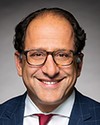Madam Chair, I could answer that.
As the minister said, the government does have a coordinated national strategy, just to assure members. There is a coordinating table. ISED plays a chairing role in that regard.
Without getting deep into the details, there are different kinds of broadband projects, and different projects have different demands. For example, it's very difficult to connect some of the very remote communities with fibre optic. We might need satellite. Deployment of satellites is going to involve different organizations than working with a small community in a suburban area. So we have the LEO project that deals with satellites.
There are projects that are close to being commercial, and with a bit of a shove they could go ahead on reasonably commercial terms, and that's the role the Infrastructure Bank plays. The Infrastructure Bank has a role. Those are generally large-scale projects involving many thousands of households, and then there are going to be these opportunistic projects where we can move quickly to maybe connect a small number of households or a small community, and that could be done through the rapid response stream, as an example.
This infrastructure is not a whole lot different from bricks and mortar. This is like building the national highway system, except that it's kind of the pipes of the future. We have a number of different instruments suited to that purpose, and we're working in a coordinated way with all our colleagues.
I would also say, Madam Chair, that we have close relations and contacts with every provincial government and with the territories as well. We work very closely with them to move these projects ahead.
I'll stop there.





